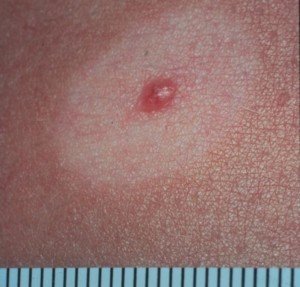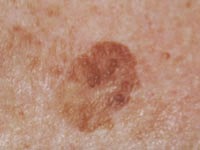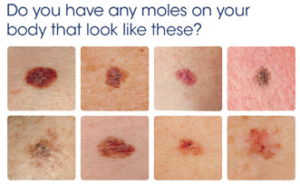
Is a fading mole, one that’s getting lighter, worrying you about melanoma?
Have you noticed a mole on your body has been fading or getting lighter?
You’ve heard that melanoma skin cancer that develops in a pre-existing mole often manifests as a mole that gets darker, even black.
But how often does melanoma present as a mole that’s suddenly starting to fade or get lighter?
Melanoma can come in the colors of brown, black, blue, grey, red and white. A melanoma mole can start changing colors.
But what if you notice a mole that’s always been dark brown, and suddenly, it just starts getting lighter or fading?
It doesn’t necessarily change size, however. The mole only fades or gets lighter.
I’ve been conducting monthly skin checks for quite a while and was always aware of a dark mole on my back, about 3 millimeters in diameter.
It was clearly what you’d consider a “dark” mole. Every month my eyes would sweep my back for anything out of the ordinary.
To get the best view, I’d sit on my sink, and with a hand mirror, look at my back through a wall mirror to the side.
The first phase consisted of standing at the sink and viewing my back with the hand mirror while my back was angled towards the side wall mirror.
Next, I’d sit on the sink for a closer view.
Finally, I’d sit back on the sink as far in as possible, twist my back and lean in funny, maneuvering the mirror awkwardly to get the closest-possible view.
One day I was viewing my hair behind my neck, not even thinking about the spot because it wasn’t time for my skin exam.
But I caught it in my peripheral vision; it was strikingly lighter.
My eyes shifted directly to it; I couldn’t believe what I was seeing:
The mole was so much lighter all of a sudden! It had always been dark!
The mole was now significantly lighter and quite faded.
“What the f—!” I thought melanoma. Melanoma.
My last skin exam had been only 25 days previous, and it had looked the way it always had.
But now, what the f—, this mole was so much lighter, completely faded! I got in closer to examine it.
The distribution pattern of the shading was changed.
However, the size and outer shape were the same as always.
I also speculated that this was another case of follicular irritation, as I had experienced this 14 months previously with another mole; the top layer suddenly began flaking off.
The dermatologist back then had told me it wasn’t melanoma, but most likely follicular irritation.
I had told her to remove the whole thing. A biopsy came back negative.
But THIS spot now?
It didn’t look like the top layer was flaking off. I wasn’t even sure if it was even elevated, because I could never get a linear, up-close-and-personal viewing due to its location, and I had to use two mirrors.
I was not able to reassure myself that it was follicular irritation. Within minutes of the discovery of this fading mole, I made an appointment with a dermatologist.
Then I did an extensive Internet search on melanoma, which I had done before on melanoma, but this time, I discovered something I never knew about: the halo nevus.

Halo nevus (mole)
I checked my mole again; there was no halo! The Internet pictures showed very striking halos, almost neon white in some cases.
So if this wasn’t follicular irritation, and since it obviously wasn’t a halo nevus, then what else could be causing the mole to get lighter and fade?
I kept thinking melanoma. Melanoma. It’s melanoma.
A halo nevus is a mole with a very light halo of skin around it; surrounding skin starts getting much lighter than the rest of the skin; the mole starts fading, getting lighter, until eventually, it completely disappears. Halo nevus is benign.
Eight days later in the dermatologist’s office, she examined the spot; her first words were, “It doesn’t look worrisome.”
I asked, “What could cause a mole to change so quickly like this?” She replied, “I don’t think it’s a mole. It looks like a seborrheic keratosis.”

Seborrheic Keratosis
SK‘s are benign growths on the skin (see above image). I had the doctor completely remove mine just in case it might be melanoma.
Three business days later, the biopsy results were in: It was a seborrheic keratosis.
In retrospect, I realize that the spot could have easily passed for an SK while I was viewing it.
But it never dawned on me that it was an SK, because the distortion created by the two mirrors, plus the fact I could not get up-close-and-personal to view it, made it look more like a mole.
So if you ever notice a mole fading or getting lighter, don’t panic; it might be an SK.
However, see a dermatologist immediately to rule out melanoma.

These are examples of melanoma.
A mole with non-uniform fading, or disappearing sections, is highly suspicious for melanoma.
These moles have regressed areas of milky white or light grey.
Kara Shah, MD and a dermatologist, discusses dangerous regressing moles.
 Lorra Garrick has been covering medical, health and personal security topics for many years, having written thousands of feature articles for a variety of print magazines and websites. She is also a former ACE-certified personal trainer.
Lorra Garrick has been covering medical, health and personal security topics for many years, having written thousands of feature articles for a variety of print magazines and websites. She is also a former ACE-certified personal trainer.
.









































